Wenrui Li
Interpretable Clustering with Adaptive Heterogeneous Causal Structure Learning in Mixed Observational Data
Sep 04, 2025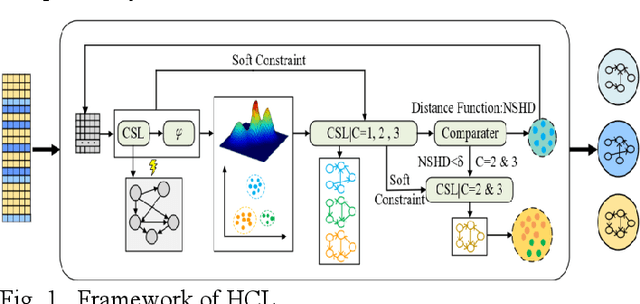
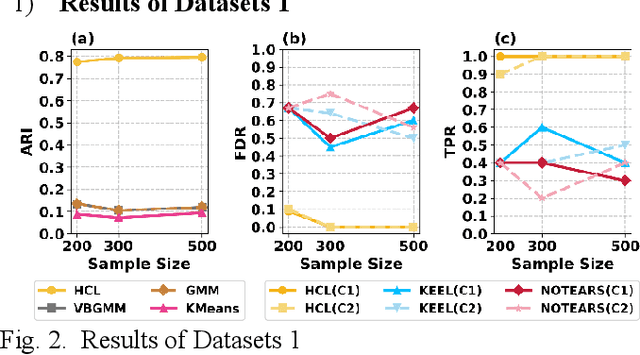
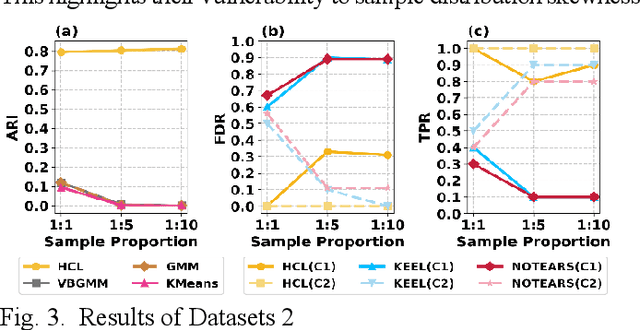
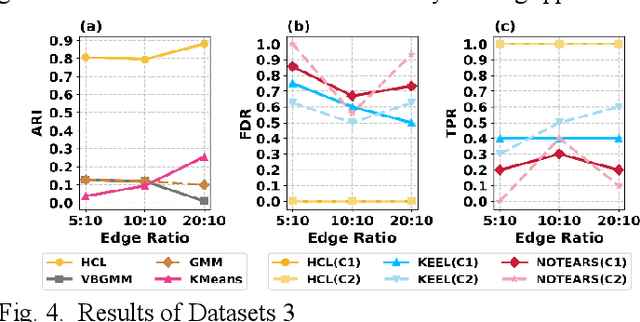
Abstract:Understanding causal heterogeneity is essential for scientific discovery in domains such as biology and medicine. However, existing methods lack causal awareness, with insufficient modeling of heterogeneity, confounding, and observational constraints, leading to poor interpretability and difficulty distinguishing true causal heterogeneity from spurious associations. We propose an unsupervised framework, HCL (Interpretable Causal Mechanism-Aware Clustering with Adaptive Heterogeneous Causal Structure Learning), that jointly infers latent clusters and their associated causal structures from mixed-type observational data without requiring temporal ordering, environment labels, interventions or other prior knowledge. HCL relaxes the homogeneity and sufficiency assumptions by introducing an equivalent representation that encodes both structural heterogeneity and confounding. It further develops a bi-directional iterative strategy to alternately refine causal clustering and structure learning, along with a self-supervised regularization that balance cross-cluster universality and specificity. Together, these components enable convergence toward interpretable, heterogeneous causal patterns. Theoretically, we show identifiability of heterogeneous causal structures under mild conditions. Empirically, HCL achieves superior performance in both clustering and structure learning tasks, and recovers biologically meaningful mechanisms in real-world single-cell perturbation data, demonstrating its utility for discovering interpretable, mechanism-level causal heterogeneity.
T-GVC: Trajectory-Guided Generative Video Coding at Ultra-Low Bitrates
Jul 10, 2025



Abstract:Recent advances in video generation techniques have given rise to an emerging paradigm of generative video coding, aiming to achieve semantically accurate reconstructions in Ultra-Low Bitrate (ULB) scenarios by leveraging strong generative priors. However, most existing methods are limited by domain specificity (e.g., facial or human videos) or an excessive dependence on high-level text guidance, which often fails to capture motion details and results in unrealistic reconstructions. To address these challenges, we propose a Trajectory-Guided Generative Video Coding framework (dubbed T-GVC). T-GVC employs a semantic-aware sparse motion sampling pipeline to effectively bridge low-level motion tracking with high-level semantic understanding by extracting pixel-wise motion as sparse trajectory points based on their semantic importance, not only significantly reducing the bitrate but also preserving critical temporal semantic information. In addition, by incorporating trajectory-aligned loss constraints into diffusion processes, we introduce a training-free latent space guidance mechanism to ensure physically plausible motion patterns without sacrificing the inherent capabilities of generative models. Experimental results demonstrate that our framework outperforms both traditional codecs and state-of-the-art end-to-end video compression methods under ULB conditions. Furthermore, additional experiments confirm that our approach achieves more precise motion control than existing text-guided methods, paving the way for a novel direction of generative video coding guided by geometric motion modeling.
Solving the Hubbard model with Neural Quantum States
Jul 03, 2025Abstract:The rapid development of neural quantum states (NQS) has established it as a promising framework for studying quantum many-body systems. In this work, by leveraging the cutting-edge transformer-based architectures and developing highly efficient optimization algorithms, we achieve the state-of-the-art results for the doped two-dimensional (2D) Hubbard model, arguably the minimum model for high-Tc superconductivity. Interestingly, we find different attention heads in the NQS ansatz can directly encode correlations at different scales, making it capable of capturing long-range correlations and entanglements in strongly correlated systems. With these advances, we establish the half-filled stripe in the ground state of 2D Hubbard model with the next nearest neighboring hoppings, consistent with experimental observations in cuprates. Our work establishes NQS as a powerful tool for solving challenging many-fermions systems.
Multi-Timescale Motion-Decoupled Spiking Transformer for Audio-Visual Zero-Shot Learning
May 26, 2025Abstract:Audio-visual zero-shot learning (ZSL) has been extensively researched for its capability to classify video data from unseen classes during training. Nevertheless, current methodologies often struggle with background scene biases and inadequate motion detail. This paper proposes a novel dual-stream Multi-Timescale Motion-Decoupled Spiking Transformer (MDST++), which decouples contextual semantic information and sparse dynamic motion information. The recurrent joint learning unit is proposed to extract contextual semantic information and capture joint knowledge across various modalities to understand the environment of actions. By converting RGB images to events, our method captures motion information more accurately and mitigates background scene biases. Moreover, we introduce a discrepancy analysis block to model audio motion information. To enhance the robustness of SNNs in extracting temporal and motion cues, we dynamically adjust the threshold of Leaky Integrate-and-Fire neurons based on global motion and contextual semantic information. Our experiments validate the effectiveness of MDST++, demonstrating their consistent superiority over state-of-the-art methods on mainstream benchmarks. Additionally, incorporating motion and multi-timescale information significantly improves HM and ZSL accuracy by 26.2\% and 39.9\%.
A High-accuracy Calibration Method of Transient TSEPs for Power Semiconductor Devices
Jan 09, 2025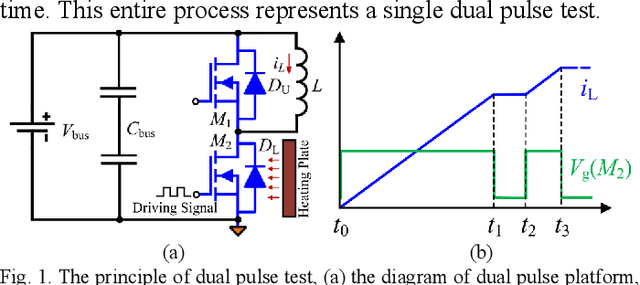
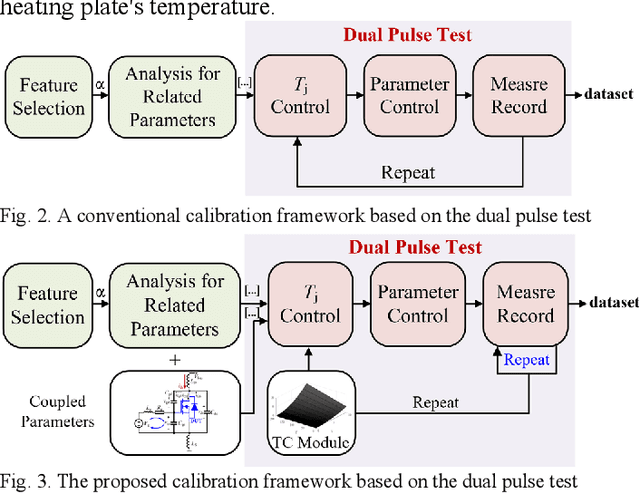
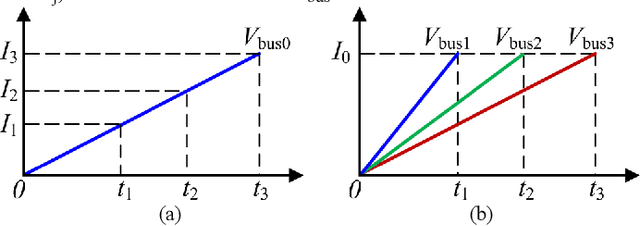
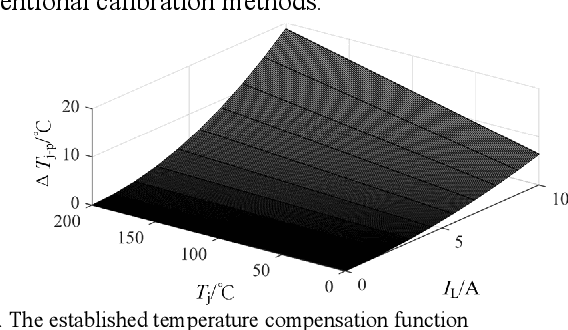
Abstract:The thermal sensitive electrical parameter (TSEP) method is crucial for enhancing the reliability of power devices through junction temperature monitoring. The TSEP method comprises three key processes: calibration, regression, and application. While significant efforts have been devoted to improving regression algorithms and increasing TSEP sensitivity to enhance junction temperature monitoring accuracy, these approaches have reached a bottleneck. In reality, the calibration method significantly influences monitoring accuracy, an aspect often overlooked in conventional TSEP methods. To address this issue, we propose a high-accuracy calibration method for transient TSEPs. First, a temperature compensation strategy based on thermal analysis is introduced to mitigate the temperature difference caused by load current during dual pulse tests. Second, the impact of stray parameters is analyzed to identify coupled parameters, which are typically neglected in existing methods. Third, it is observed that random errors follow a logarithm Gaussian distribution, covering a hidden variable. A neural network is used to obtain the junction temperature predictive model. The proposed calibration method is experimental validated in threshold voltage as an example. Compared with conventional calibration methods, the mean absolute error is reduced by over 30%. Moreover, this method does not require additional hardware cost and has good generalization.
Discrepancy-Aware Attention Network for Enhanced Audio-Visual Zero-Shot Learning
Dec 16, 2024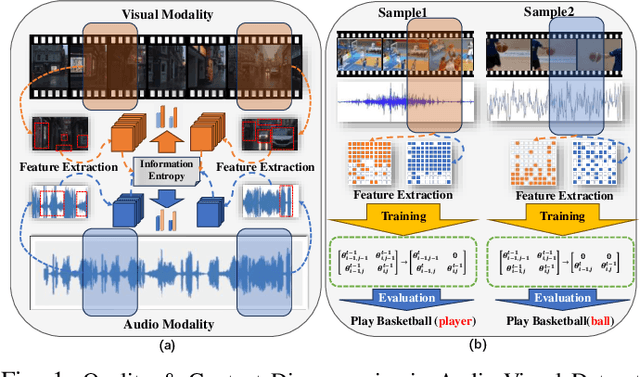
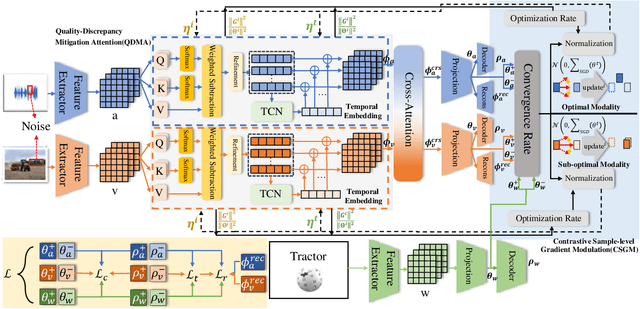
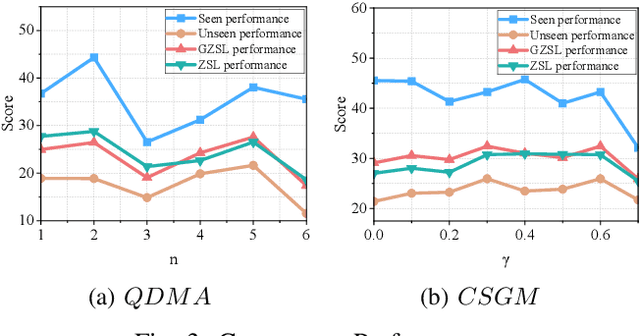

Abstract:Audio-visual Zero-Shot Learning (ZSL) has attracted significant attention for its ability to identify unseen classes and perform well in video classification tasks. However, modal imbalance in (G)ZSL leads to over-reliance on the optimal modality, reducing discriminative capabilities for unseen classes. Some studies have attempted to address this issue by modifying parameter gradients, but two challenges still remain: (a) Quality discrepancies, where modalities offer differing quantities and qualities of information for the same concept. (b) Content discrepancies, where sample contributions within a modality vary significantly. To address these challenges, we propose a Discrepancy-Aware Attention Network (DAAN) for Enhanced Audio-Visual ZSL. Our approach introduces a Quality-Discrepancy Mitigation Attention (QDMA) unit to minimize redundant information in the high-quality modality and a Contrastive Sample-level Gradient Modulation (CSGM) block to adjust gradient magnitudes and balance content discrepancies. We quantify modality contributions by integrating optimization and convergence rate for more precise gradient modulation in CSGM. Experiments demonstrates DAAN achieves state-of-the-art performance on benchmark datasets, with ablation studies validating the effectiveness of individual modules.
Hyperbolic-constraint Point Cloud Reconstruction from Single RGB-D Images
Dec 12, 2024Abstract:Reconstructing desired objects and scenes has long been a primary goal in 3D computer vision. Single-view point cloud reconstruction has become a popular technique due to its low cost and accurate results. However, single-view reconstruction methods often rely on expensive CAD models and complex geometric priors. Effectively utilizing prior knowledge about the data remains a challenge. In this paper, we introduce hyperbolic space to 3D point cloud reconstruction, enabling the model to represent and understand complex hierarchical structures in point clouds with low distortion. We build upon previous methods by proposing a hyperbolic Chamfer distance and a regularized triplet loss to enhance the relationship between partial and complete point clouds. Additionally, we design adaptive boundary conditions to improve the model's understanding and reconstruction of 3D structures. Our model outperforms most existing models, and ablation studies demonstrate the significance of our model and its components. Experimental results show that our method significantly improves feature extraction capabilities. Our model achieves outstanding performance in 3D reconstruction tasks.
Digging into Intrinsic Contextual Information for High-fidelity 3D Point Cloud Completion
Dec 11, 2024Abstract:The common occurrence of occlusion-induced incompleteness in point clouds has made point cloud completion (PCC) a highly-concerned task in the field of geometric processing. Existing PCC methods typically produce complete point clouds from partial point clouds in a coarse-to-fine paradigm, with the coarse stage generating entire shapes and the fine stage improving texture details. Though diffusion models have demonstrated effectiveness in the coarse stage, the fine stage still faces challenges in producing high-fidelity results due to the ill-posed nature of PCC. The intrinsic contextual information for texture details in partial point clouds is the key to solving the challenge. In this paper, we propose a high-fidelity PCC method that digs into both short and long-range contextual information from the partial point cloud in the fine stage. Specifically, after generating the coarse point cloud via a diffusion-based coarse generator, a mixed sampling module introduces short-range contextual information from partial point clouds into the fine stage. A surface freezing modules safeguards points from noise-free partial point clouds against disruption. As for the long-range contextual information, we design a similarity modeling module to derive similarity with rigid transformation invariance between points, conducting effective matching of geometric manifold features globally. In this way, the high-quality components present in the partial point cloud serve as valuable references for refining the coarse point cloud with high fidelity. Extensive experiments have demonstrated the superiority of the proposed method over SOTA competitors. Our code is available at https://github.com/JS-CHU/ContextualCompletion.
SceneDreamer360: Text-Driven 3D-Consistent Scene Generation with Panoramic Gaussian Splatting
Aug 25, 2024



Abstract:Text-driven 3D scene generation has seen significant advancements recently. However, most existing methods generate single-view images using generative models and then stitch them together in 3D space. This independent generation for each view often results in spatial inconsistency and implausibility in the 3D scenes. To address this challenge, we proposed a novel text-driven 3D-consistent scene generation model: SceneDreamer360. Our proposed method leverages a text-driven panoramic image generation model as a prior for 3D scene generation and employs 3D Gaussian Splatting (3DGS) to ensure consistency across multi-view panoramic images. Specifically, SceneDreamer360 enhances the fine-tuned Panfusion generator with a three-stage panoramic enhancement, enabling the generation of high-resolution, detail-rich panoramic images. During the 3D scene construction, a novel point cloud fusion initialization method is used, producing higher quality and spatially consistent point clouds. Our extensive experiments demonstrate that compared to other methods, SceneDreamer360 with its panoramic image generation and 3DGS can produce higher quality, spatially consistent, and visually appealing 3D scenes from any text prompt. Our codes are available at \url{https://github.com/liwrui/SceneDreamer360}.
Riemann-based Multi-scale Attention Reasoning Network for Text-3D Retrieval
Aug 25, 2024Abstract:Due to the challenges in acquiring paired Text-3D data and the inherent irregularity of 3D data structures, combined representation learning of 3D point clouds and text remains unexplored. In this paper, we propose a novel Riemann-based Multi-scale Attention Reasoning Network (RMARN) for text-3D retrieval. Specifically, the extracted text and point cloud features are refined by their respective Adaptive Feature Refiner (AFR). Furthermore, we introduce the innovative Riemann Local Similarity (RLS) module and the Global Pooling Similarity (GPS) module. However, as 3D point cloud data and text data often possess complex geometric structures in high-dimensional space, the proposed RLS employs a novel Riemann Attention Mechanism to reflect the intrinsic geometric relationships of the data. Without explicitly defining the manifold, RMARN learns the manifold parameters to better represent the distances between text-point cloud samples. To address the challenges of lacking paired text-3D data, we have created the large-scale Text-3D Retrieval dataset T3DR-HIT, which comprises over 3,380 pairs of text and point cloud data. T3DR-HIT contains coarse-grained indoor 3D scenes and fine-grained Chinese artifact scenes, consisting of 1,380 and over 2,000 text-3D pairs, respectively. Experiments on our custom datasets demonstrate the superior performance of the proposed method. Our code and proposed datasets are available at \url{https://github.com/liwrui/RMARN}.
 Add to Chrome
Add to Chrome Add to Firefox
Add to Firefox Add to Edge
Add to Edge